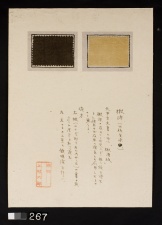Difference between revisions of "Hisagi /Akamekashiwa - right (267 R)"
Jump to navigation
Jump to search
(username removed) |
(username removed) |
||
| (One intermediate revision by the same user not shown) | |||
| Line 5: | Line 5: | ||
| 267 | | 267 | ||
|- | |- | ||
| − | ! scope="row"| | + | ! scope="row"|Uemura number / title |
| − | | | + | | ; "Haze-some 25" |
|- | |- | ||
! scope="row"|Folder location | ! scope="row"|Folder location | ||
| Line 41: | Line 41: | ||
| ash water | | ash water | ||
|- | |- | ||
| − | ! scope="row"| | + | ! scope="row"|Uemura's notes |
| − | | Use of this plant for dyeing paper ( | + | | Use of this plant for dyeing paper () is recorded in manuscripts from the Tempyo period (729 - 749 AD), Japan. The application on textiles is not found there, however it could have been possible. |
|- | |- | ||
| − | ! scope="row"| | + | ! scope="row"|Uemura's date |
| Kyoto | | Kyoto | ||
|} | |} | ||
| − | [[Category: | + | [[Category:Uemura dye archive]] |
Latest revision as of 06:19, 24 July 2013
| Museum number | 267 |
|---|---|
| Uemura number / title | ; "Haze-some 25" |
| Folder location | 4th shelf |
| Sample location | right (267 R) |
| Fiber type | silk |
| Color | yellow beige |
| Dyestuff (Japanese common name) | 楸 /あかめかしわ : Hisagi /Akamekashiwa |
| Dyestuff (botanical name) | Mallotus japonicus (L.f.) Mll. Arg. |
| Plant part | leaf / dried (?) |
| Dyestuff extraction | boiled in water |
| Auxiliary agent in dye bath | - |
| Mordant | - |
| Other auxiliary agent | ash water |
| Uemura's notes | Use of this plant for dyeing paper () is recorded in manuscripts from the Tempyo period (729 - 749 AD), Japan. The application on textiles is not found there, however it could have been possible. |
| Uemura's date | Kyoto |
